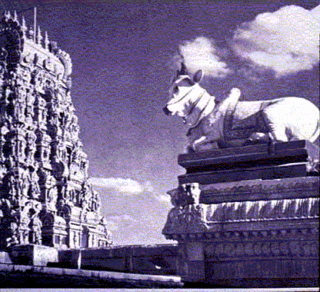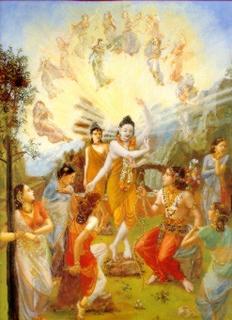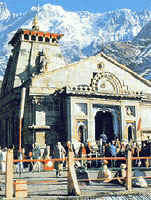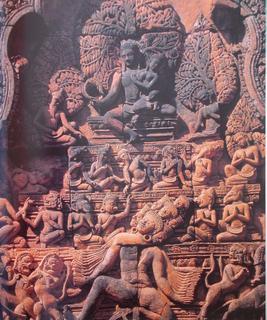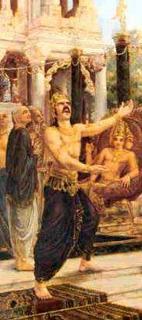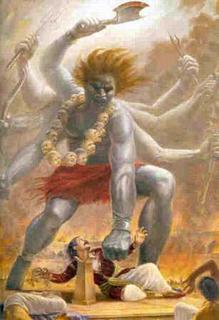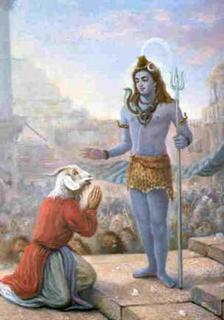Often I have thought on the probability of resemblance between Science and Religion. Is there a chance that our ancestors wanted to convey some important facts about the cosmos through means of religious texts.
Whereas spirituaity is individual in qulaity, religion is very tightly coupled with society and its norms.
Were these norms established in any way to relate our lives to the wider cosmos we are part of?
Shiva has always been the essence of live and his actions not only affect life in its human form but also life in its cosmic existence.
Some aspects of Shiva, which according to my very limited thinking, may relate to life beyond earth and humanity.
Tandava:
Dancing is an ancient form of magic. The dancer becomes amplified into a being endowed with supra-normal powers. His personality is transformed. Like yoga, the dance induces trance, ecstasy, the experience of the divine, the realization of one's own secret nature, and, finally, mergence into the divine essence. In India consequently the dance has flourished side by side with the terrific austerities of the meditation grove- fasting, breathing exercises, absolute introversion. To work magic, to put enchantments upon others, one has first to put enchantments on oneself. And this is effected as well by the dance as by prayer, fasting and meditation. Shiva, therefore, the arch-yogi of the gods, is necessarily also the master of the dance. The dance is an act of creation. It brings about a new situation and summons into the dancer a new and higher personality. It has a cosmogonic function, in that it rouses dormant energies which them may shape the world. On a universal scale, Shiva is the Cosmic Dancer; in his Dancing Manifestation (nritya-murti) he embodies in himself and simultaneously gives manifestation to Eternal Energy. The forces gathered and projected in his frantic, ever-enduring gyration, are the powers of the evolution, maintenance, and dissolution of the world. Nature and all its creatures are the effects of his eternal dance.
Analysis of the Nataraja Rupa of Shiva:
The upper right hand, it will be observed, carries a little drum, shaped like an hour-glass, for the beating of the rhythm. This connotes Sound, the vehicle of speech, the conveyer of revelation, tradition, incantation magic and divine truth. Furthermore, Sound is associated in India with Ether, the first of the five elements. Ether is the primary and most subtly pervasive evolution of the universe, all the other elements, Air, Fire, Water, and Earth. Together, therefore, Sound and Ether signify the first, truth-pregnant moment of creation, the productive energy of the Absolute, in its pristine, cosmogenetic strength.
The opposite hand, the upper left, with a half-moon posture of the figure (ardhacandra-mudra), bears on its palm a tongue of flame. Fire is the element of the destruction of the world. At the close of the Kali Yuga, Fire will annihilate the body of creation, to be itself then quenched by the ocean of the void.
Here, then, in the balance of the hands, is illustrated a counterpoise of creation and destruction in the play of the cosmic dance. Sound against flame. And the field of the terrible interplay is the Dancing Ground of the Universe, brilliant and horrific with the dance of the god.
The fear not gesture (abhaya-mudra), bestowing protection and peace, is displayed by the second right hand, while the remaining left lifted across the chest, points downward to the uplifted left foot. This foot signifies Release, and is the refuge and salvation of the devotee. It is to be worshipped for the attainment of union with the Absolute.
The hand pointing to it is held in a pose imitative of the outstretched trunk or hand of the elephant (gaja-hasta-mudra), reminding us of Ganesha, Shiva's son, the Remover of Obstacles.
The divinity is represented as dancing on the postrate body of a dwarfish demon. This is Apasmara Purusha, ?The Man or Demon (purusha) called Forgetfulness, or Heedlessness (apasmara). It is symbolical of life?s blindness, man's ignorance. Therein is release from the bondages of the world.
A ring of flames and light (prabha-mandala) issues from and encompasses the god. This is said to signify the vital processes of the universe and its creatures, nature's dance as moved by the dancing god within. Simultaneously it is said to signify the energy of Wisdom, the transcendental light of the knowledge of truth, dancing forth, from the personification of the All.
Still another allegorical meaning assigned to the halo of flames is that of the holy syllable of AUM or OM. This mystical utterance stemming from the sacred language of Vedic praise and incantation, is understood as an expression and affirmation of the totality of creation.
A – is the state of waking consciousness, together with its world of gross experience.
U – is the state of dreaming consciousness, together with its experience of subtle shapes of dream.
M – is the state of dreamless sleep, the natural condition of quiescent, undifferentiated consciousness, wherein every experience is dissolved into a blissful non-experience, a mass of potential consciousness.
The silence following the pronunciation of the three, A,U, and M, is the ultimate un-manifest, wherein perfected supra-consciousness totally reflects and merges with the pure, transcendental essence of Divine Reality – Brahman is experienced as Atman, the Self. AUM, therefore, together with its surrounding silence, is a sound-symbol of the whole of consciousness-existence, and at the same time its willing affirmation.
Shiva as the Cosmic Dancer is the embodiment and manifestation of eternal energy in its 'five activities' (panch-kriya)
Creation (sristi) – the pouring forth or unfolding
Maintenance (sthiti) – the duration
Destruction (samhara) – the taking back or reabsorption
Concealment (tiro-bhava) – the veiling of True Being behind the masks and garbs of apparitions, aloofness, display of Maya,
Favor (anugraha) – acceptance of the devotee, acknowledgment of the pious endeavor of the yogi, bestowal of peace.
In the Shiva-Trinity of Elephanta Caves we saw that the two expressive profiles, representing the polarity of the creative force, were counterpoised to a single, silent, central head, signifying the quiescence of the Absolute. And we deciphered this symbolic relationship as eloquent of the paradox of Eternity and Time: the reposeful ocean and the racing stream are not finally distinct; the indestructible Self and the mortal being are in essence the same. This wonderful lesson can be read also in the figure of Shiva-Nataraja, where the incessant, triumphant motion of the swaying limbs is in significant contrast to the balance of the head and immobility of the mask-like countenance.
Shiva is Kala, 'The Black One' 'Time'; but he is also Maha Kala, 'Great Time', 'Eternity'. As Nataraja, King of Dancers, his gestures, wild and full of grace, precipitate the cosmic illusion; his flying arms and legs and the swaying of his torso produce – indeed, they are – the continuous creation-destruction of the universe, death exactly balancing birth, annihilation the end of every coming-forth. The choreography is the whirligig of time. History and its ruins, the explosion of suns, are flashes from the tireless swinging sequence of the gestures. In the medieval bronze figurines, not merely a single phase or movement, but cyclic rhythm, flowing on and non in the unstayable, irreversible round of the Mahayugas, or Great Eons, is marked by the beating and stamping of the Master's heel.
But the face remains, meanwhile, in sovereign calm.
Shiva is the personification of the Absolute, particularly in its dissolution of the universe.
He is the embodiment of Super-Death. He is called Yamantaka – 'The Ender of the Tamer' , He who conquers and exterminates Yama the God of Death, the Tamer. Shiva is Maha-Kala, Great Time, Eternity, the swallower of Time, swallower of Ages and cycles of ages.
Shiva is apparently, thus, two opposite things, archetypal ascetic, and archetypal dancer. On one hand , he is Total Tranquility – inward calm absorbed in itself, absorbed in the void of the Absolute, where all distintions merge and dissolve, and all tensions are at rest. But on the other hand, he is Total Activity – life's energy, frantic, aimless, and playful.
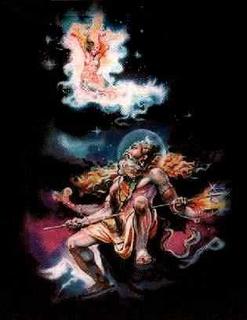
The Descend of Ganga:I have always felt that the descend of Ganga may symbolize a cosmic phenomenon.
I had this idea by speculation on the fractal nature of the universe.
The smaller atom represents the bigger universe.
By this theory could the concentration of heavenly Ganga in the matted locks of Shiva, a point of singularity, and then out of it on Earth symbolize the phenomenon of universe travel for humanity?
Just my very own personal thought.
 Cosmology:
Cosmology:
Black hole
A black hole is a concentration of mass great enough that the force of gravity prevents anything from escaping from it except through quantum tunneling behavior. The gravitational field is so strong that the escape velocity near it exceeds the speed of light. This implies that nothing, not even light, can escape its gravity, hence the word "black". The term "black hole" is widespread, even though it does not refer to a hole in the usual sense, but rather a region of space from which nothing can return.
White hole
In astrophysics, a white hole is a postulated celestial body that spews out matter, in other words an anti-black hole, or the time reversal of a black hole.
White holes have long been speculated about in Science Fiction. They have been postulated as a means of transport between points of spacetime and even different universes. Due to a black hole's suggested funnel-like nature, matter travelling through a black hole and exiting through a white hole would be crushed to an immensely dense but small size, this would go against transportation because it is very unlikely that a white hole would have the ability to recompose the matter to its original state prior to entering the black hole. The existence of white holes is hypothetical, as they appear to violate the second law of thermodynamics.
Other speculations include the hypothesis that quasars are actually white holes instead of supermassive black holes.
Worm hole
In physics, a wormhole, also known as an Einstein-Rosen bridge (and less commonly as an Einstein-Rosen-Podolsky bridge or Einstein-Podolsky-Rosen bridge), is a hypothetical topological feature of spacetime that is essentially a "shortcut" through space and time. A wormhole has at least two mouths which are connected to a single throat. Matter can 'travel' from one mouth to the other by passing through the throat.
The name "wormhole" comes from the following analogy used to explain the phenomenon: imagine that the universe is the skin of an apple, and a worm is traveling over its surface. The distance from one side of the apple to the other is equal to half the apple's circumference if the worm stays on the apple's surface, but if it instead burrows a wormhole directly through the apple the distance it has to travel is considerably less.
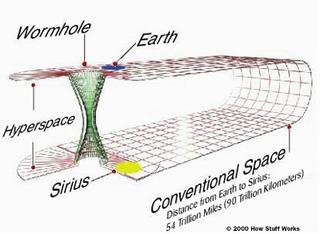
So what is the point that I want to make?
Duality is a concept that has always been associated with Shiva.
He is Ardhanireshwar. He is the inficter of Death and the lord of Regeneration as well.
So, if we consider the functions of the Trinity on a cosmic level, the concept of worm hole makes a lot of sense.
Trinity, is nothing, but the manifestion of Shiva.
Here I would particularly like to mention about an article by Tom Beal.
"
Exploring the universe, modern scientists have discovered the current principles of Brahma, Shiva and Vishnu at work. The ancient rishis and their study of Vedic astrology clearly were the founders of modern day astronomy. As observers of the truth, which is what the Vedas is a copulation of, they observed celestial bodies, their movements and the effects on the human psyche. Introducing truths about the nature of the universe that are only beginning to be re-discovered today by “cutting edge” minds and the most brilliant of scientist using the latest equipment. The rishis where able to achieve this with only the power of the mind and awareness of the true essence of consciousness, no equipment was required! While the rishi’s of Vedic times used terms such as Agni, Indra, and Soma as important deities, it was understood that over time different terms and names would be used by humanity. For the purpose of clarity we will use the terms Brahma, Shiva, and Vishnu. They will more clearly illustrate the concepts of this article. The rishis tell us of the galactic center of the universe, which feeds energy to all the galaxies and solar systems of the universe. A modern discovery is beginning to reinforce this belief. To explore this three centers must be identified, 1) the center of a solar system (Sun), 2) The center of a galaxy, 3) the galactic center of the universe. Our focus here will be on the first two centers. In exploring these two centers we will discover the current Hindu principles of Brahma, Shiva and Vishnu at work. Those these same principles can be explored using the galactic center of the universe also. Before beginning it is important to understand what the theory of a blackhole is. While this is a vast and complex subject, we will try and provide a brief introduction. A blackhole is a star that has consumed so much of its energy that it no longer is able to release that energy and becomes overwhelmed by its own gravitational forces. In essence collapsing in on itself. This collapse actually creates a tear or warp in the fabric of the universe. This warp is theorized to bend time and space, it is a place where the laws of physics possibly don’t exist as we know them. Space and time become infinite.It all began with the search for blackholes in the universe. Originally there was only a theory about the existence of blackholes, but over time using radio telescopes scientist began to receive glimpses of blackholes but only while they were “feeding” or consuming matter. It is during this “feeding” time that particles are expelled through the polar points of a blackhole, allowing it to be seen with radio telescopes. Over time a blackhole was discovered in the center of a galaxy. The question arose “could there be more blackholes at the center of a few galaxies?” After watching matter and objects “warble” while circling the center of galaxies, it was discovered that most if not all galaxies have a blackhole at their center. This was a revolutionary discovery since blackholes are viewed primarily as destructive devises. This clearly is one of the many aspects of Shiva, but functioning on the scale of a galaxy. The next question for the scientist was “why do blackholes appear to turn on and off with their “feeding”?” With their tremendous gravitational pull blackholes should consume an entire galaxy over time. The discovery was quite exciting. It was discovered that “winds” or energy being released at the poles of the blackhole actually pushes against the matter of the galaxy, which is being pulled by the gravity of the blackhole. Once the wind from the blackhole equals the pull of the gravitational field from the blackhole equilibrium is obtained and the blackhole stops “feeding”. This balance or preservation principle is a manifestation of Vishnu. If this balance is disturbed the Vishnu principle stops and the destructive principle of Shiva begins until equilibrium is obtained again. The energy being ejected from the blackhole becomes the basis for creation within the galaxy (Brahma). This process can even be observed in the actual blackhole itself. When the blackhole is not “feeding” equilibrium exists and the Vishnu principle dominates. Though the Brahma and Shiva principles are still in existence, we will explore this in just a moment. If equilibrium is lost then the Shiva principle of destruction activates through the blackhole beginning to “feed” again. This feeding causes the expulsion of molecules and initiates the creation principle again. We can even go so far as to see that this process of is occurring on the molecular level of the blackhole itself. Steven Hawking proved mathematically that it is possible for the blackhole, even with its tremendous gravity, to slowly lose a molecule at a time. So over time a blackhole will eventually cease to exist due to the loss of molecules. Once again the loss of molecules (Shiva-the destruction of the blackhole), will eventually lead to more creation (Brahma-through the molecules being some of the building blocks of matter—escaping the infinite time/space, and generating finite time/space matter), and all of this occurs even during the period that the blackhole is “not active” or feeding; what we would call balance or the Vishnu principle.We can see the trinity (Shiva, Brahma, and Vishnu) manifest even in the physics and quantam physics formulas for calculating the event horizon of blackholes. Which is the only current way known to estimate the size of a blackhole. The event horizon is the point in which light can no longer escape from the gravitational pull of a blackhole. The mathematical formula is GM/c2 where G is the gravitational constant, M is the mass of the black hole and C is the speed of light. In this formula G can be viewed as Vishnu, Brahma would be the factor M, and Shiva would be C. It should be noted that depending on how one were to look at it the roles of Shiva and Brahma could be reversed i.e. Shiva=M and Brahma=C. A similar process exists on the solar system level also. Equilibrium is obtained between the Sun and planets (Vishnu), eventually the Sun will go super nova and destroy this solar system (Shiva), only to begin the long process of creation again (Brahma). Even within the balance of the solar system (Vishnu), Brahma can still be seen at work through the solar winds and magnetic waves from the sun that are channeled to the poles and stimulate the inner core of the earth giving physical manifestation to Agni on the earthly plane. The greatest gift the Rishis left for us is a reminder of the power of mind and an understanding of consciousness. With these two, we each are reminded that we truly are a limitless, boundless, being. Overtime scientist will re-discover the Vedic truth, that all the universe is fed from the galatic center. This will open the door for the realization that man exists within a huge field of gravitational and magnetic impulses. These flows are reflected by the planets (grahas). It will be realized that mankind has actually had the ability to read these fields from at least 6000 BCE. It is important to note that Shiva, Brahma, and Vishnu are much more than just forces within blackholes, or the galaxy. But being terms for the divine truth, they must have their representation in all things. We must learn to see the trinity of divine principles (Gods) manifest in all aspects of life and creation. To see and understand this was the ability of our ancient ancestors, and it is each of ours birthright.
"
Yogi Harinam Baba PremFebruary 22, 2004
Sources and reference:Frawley, David. “Gods, Sages, and Kings” Salt Lake City, Utah: Passage Press, 1991Frawley, David. “Astrology of the Seers” Twin Lakes, Wisconsin: Lotus Press, 2000
I would just differ on one partiular aspect of this article. Whereas Tom sees the Trinity as individuals, I see "them" as manifestations of "The One", the auspicious one, Shiva

